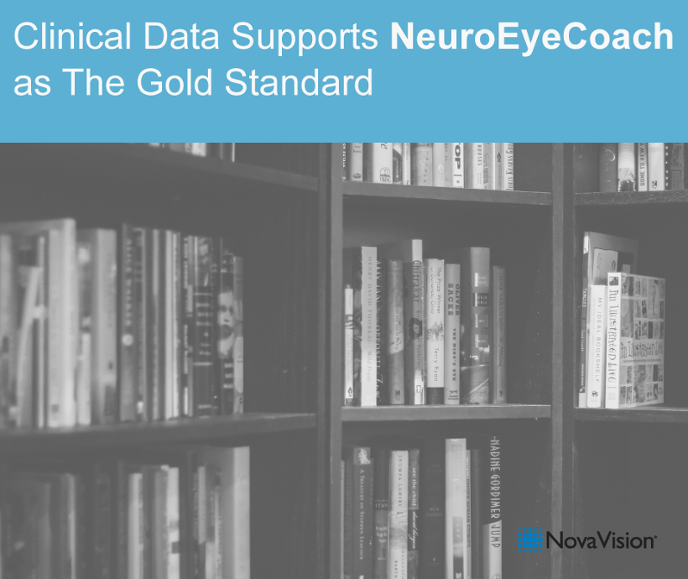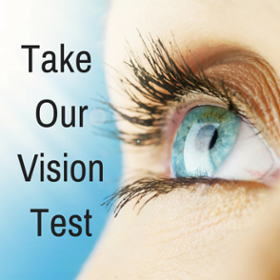
It’s important to develop techniques to help patients to compensate for their sight deficits and NeuroEyeCoach is providing a much needed step forward in providing therapy for these patients in order to improve the quality of life for the individual. We have used this type of compensatory technique in vision research for some time now and in NeuroEyeCoach, we have developed the research into an accessible treatment that can help patients achieve major improvements in their vision within about 2-3 weeks.”
– Professor Arash Sahraie, Head of the School of Psychology, University of Aberdeen
Clinical Study Supports NeuroEyeCoach as The Gold Standard for Neurological Vision Therapy
A rigorous peer-reviewed study published in BioMed Research International shows improvements in visual search following the use of NovaVision’s NeuroEyeCoach. The three-center study was conducted by the School of Psychology of University of Aberdeen, the Neuromotor and Cognitive Rehabilitation Research Center of University of Verona, and the Department of Psychology of University of Munich.
“This type of sight deficit can be massively debilitating for those affected by it”, said Professor Arash Sahraie, head of the school of psychology at the University of Aberdeen who led the study. “Patients report a loss of confidence in their own ability to navigate the environment that can then manifest itself in the form of withdrawal from daily life. This is why it’s important to develop techniques to help patients to improve as much as they can and this compensatory technique is yet another step forward in providing help and therapy for these patients.”
The study concludes “NeuroEyeCoach can be used as an effective rehabilitation tool to develop compensatory strategies in patients with visual field deficits after brain injury” and that NeuroEyeCoach can be viewed as beingthe first evidence-based, vision-specific, clinical gold standard registered medical device accessible to patients at home or in clinical settings.
Background:
Many patients who have a visual field deficit after suffering a stroke or brain injury also have difficulties with eye movements. They are less efficient at processing their visual field, moving their eyes around less, exploring more of the region they can see rather than trying to explore the “blind areas”, and are less able to integrate information between the left and right hand side of their vision. Therefore, they have less awareness of things happening at the side of their visual field and are not able to grasp a scene as a whole, and as a result bump into objects or perceive a problem with their peripheral vision.
Only about 20% of people are able to recover without clinical intervention. The use of visual search in improving the search efficiency of hemianopic patients was first reported in 1988. Other than its use in a limited number of research environments or rehabilitation clinics over the past 25 years, there has been a marked lack of an evidence-based, vision-specific medical device broadly accessible to patients, despite there being a large body of evidence including randomized control trials showing that patients benefit from systematic eye movement training.
Therapists and physicians in clinical practice have instead used a number of devices that originally had been designed to address other problems; these do not have a set of systematically developed protocols specific to visually impaired patients and are therefore sub-optimum for their rehabilitation.
Program Description:
NeuroEyeCoach was developed to address this need and provide a standardized protocol for clinical management of patients using a compensatory technique. The program systematically increases the task difficulty from a simple “pop-out” search, to more complex search with multiple distractors, and finally conjunction searches where distractor number and target/distractor similarity are manipulated. The program has been designed to be highly intuitive, using simple on-screen and audio instructions, and automatically adjusting to the patient’s ability and progress. This ensures that this therapy is appropriate for use unsupervised at home as well as under supervision in clinical settings.
The Key Study Findings
Three distinct observational studies were performed as part of the new overall study;
1. The first objective was to confirm that NeuroEyeCoach did indeed provide at least as positive outcomes as the large body of clinical evidence upon which the program was based. The use of computerized visual search tasks as a rehabilitation tool to improve eye movements after brain injury had previously been used in 14 studies with a total of 593 patients with homonymous visual field loss and persistent visual disabilities. Each of the studies focused on different aspects however, in aggregate, the outcome of the studies demonstrated a significant improvement in visual search performance accompanied by more efficient oculomotor strategies and a reduction in visual disability as assessed with standard questionnaires and behavioral measures.
The first study concluded that patients showed similar improvements to prior studies with regard to visual search and reported functioning in daily life activities with the added advantage of having set criteria for progression to different levels of difficulty.
2. The second objective was to find out whether the program-inbuilt, self-administered outcome measures can be used to assess patients’ NeuroEyeCoach therapy outcomes, whether this additional cohort of patients benefitted from visual search training and whether changes are measurable using the incorporated pre- and post-assessments.
The second study concluded that this cohort of patients also benefited from eye movement training and that this benefit could be assessed effectively using the program’s inbuilt outcome measures. The training led to faster visual search times, reduction in the number of errors made, and improvements in self-reported activities of daily living.
3. The third study focused on the comparison of changes in visual search in a group of patients with those of a similarly-aged control group of healthy subjects (“normal controls”), with both groups conducting the therapy under supervision at clinical rehab units.
The findings from this final study showed that the use of NeuroEyeCoach in patients can lead to more than TWICE the magnitude of improvements compared to normal controls. This evidenced that patients suffering from homonymous visual field benefitted far beyond simple program familiarity, but regained an effective scanning strategy to substitute for the lost visual field, which the study highlights as being a crucial prerequisite for grasping the actual surroundings with high accuracy and speed.
 Conclusion
Conclusion
“NeuroEyeCoach is an effective compensatory approach for those with homonymous visual field loss. The training led to faster visual search times, reduction in the number of errors made, and improvements in reported activities of daily living”.
If you or someone you know can benefit from our vision therapies and would like to get started or want more information you can contact us directly at 888.205.0800 or find out more about our vision therapy suite here


